Ảnh hưởng của lời dẫn tường minh cho các chiến lược đọc đến kỹ năng đọc hiểu tại khoa Ngoại ngữ, Đại học Thái Nguyên
Bài viết nghiên cứu về ảnh hưởng của lời dẫn tường minh cho các chiến lược đọc hiểu đến kỹ năng
đọc hiểu tại Khoa Ngoại ngữ, Đại học Thái Nguyên và thái độ của sinh viên đối với kỹ thuật này
trong tiết học đọc. Để đạt đựơc mục tiêu nghiên cứu, tác giả đã sử dụng phương pháp phân tích
định tính và định lượng, với các công cụ: bài kiểm tra trước và sau, và bảng câu hỏi khảo sát. Sau
10 tuần tiến hành thử nghiệm, kết quả của các bài kiểm tra đọc hiểu và bảng hỏi đã thể hiện rằng
lời dẫn tường minh về các chiến lược đọc hiểu giúp sinh viên tăng cường kỹ năng đọc hiểu. Kết
quả còn cho thấy lời dẫn tường minh đồng thời giúp sinh viên dường như tự tin hơn với việc học
kỹ năng đọc.
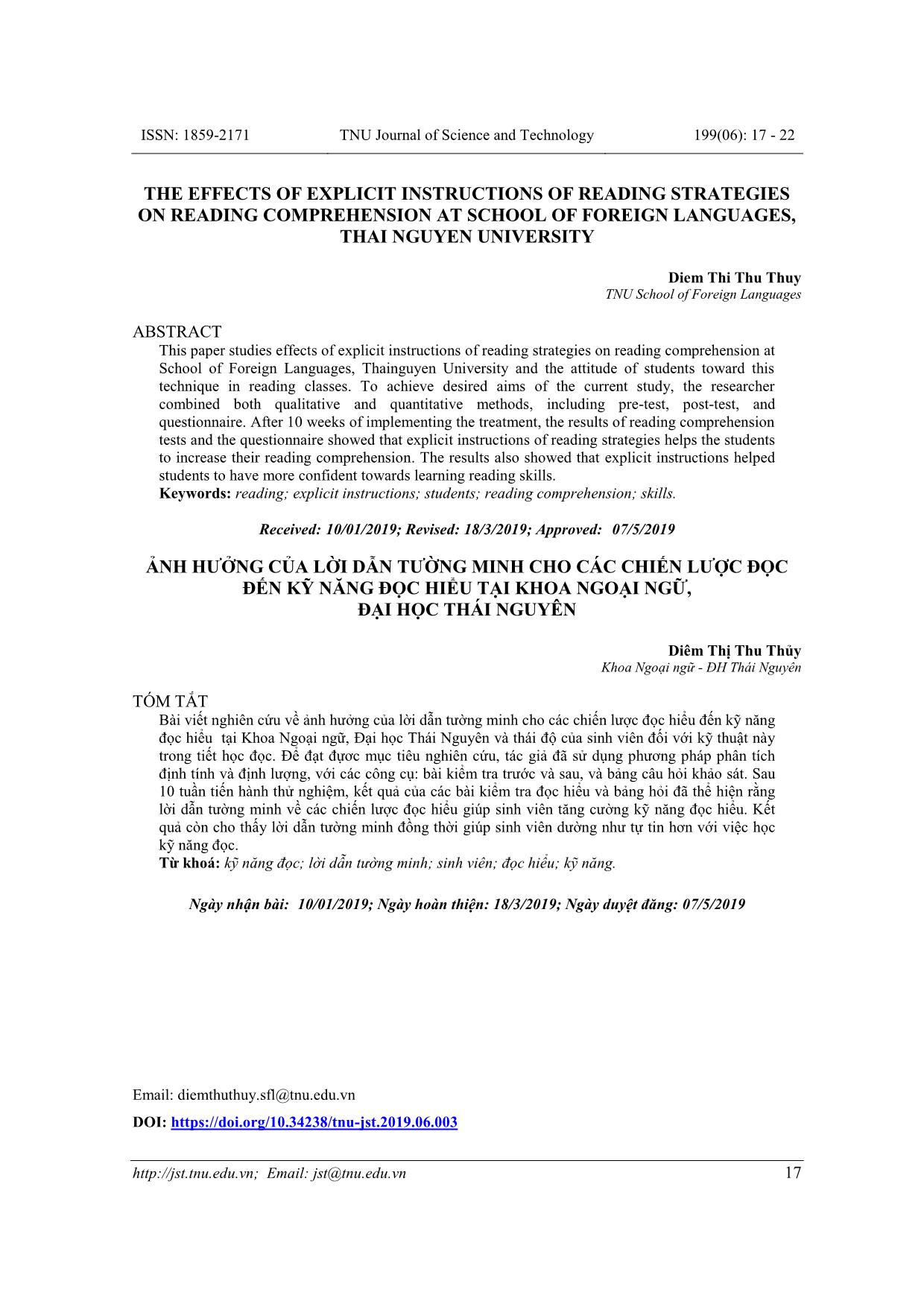
Trang 1
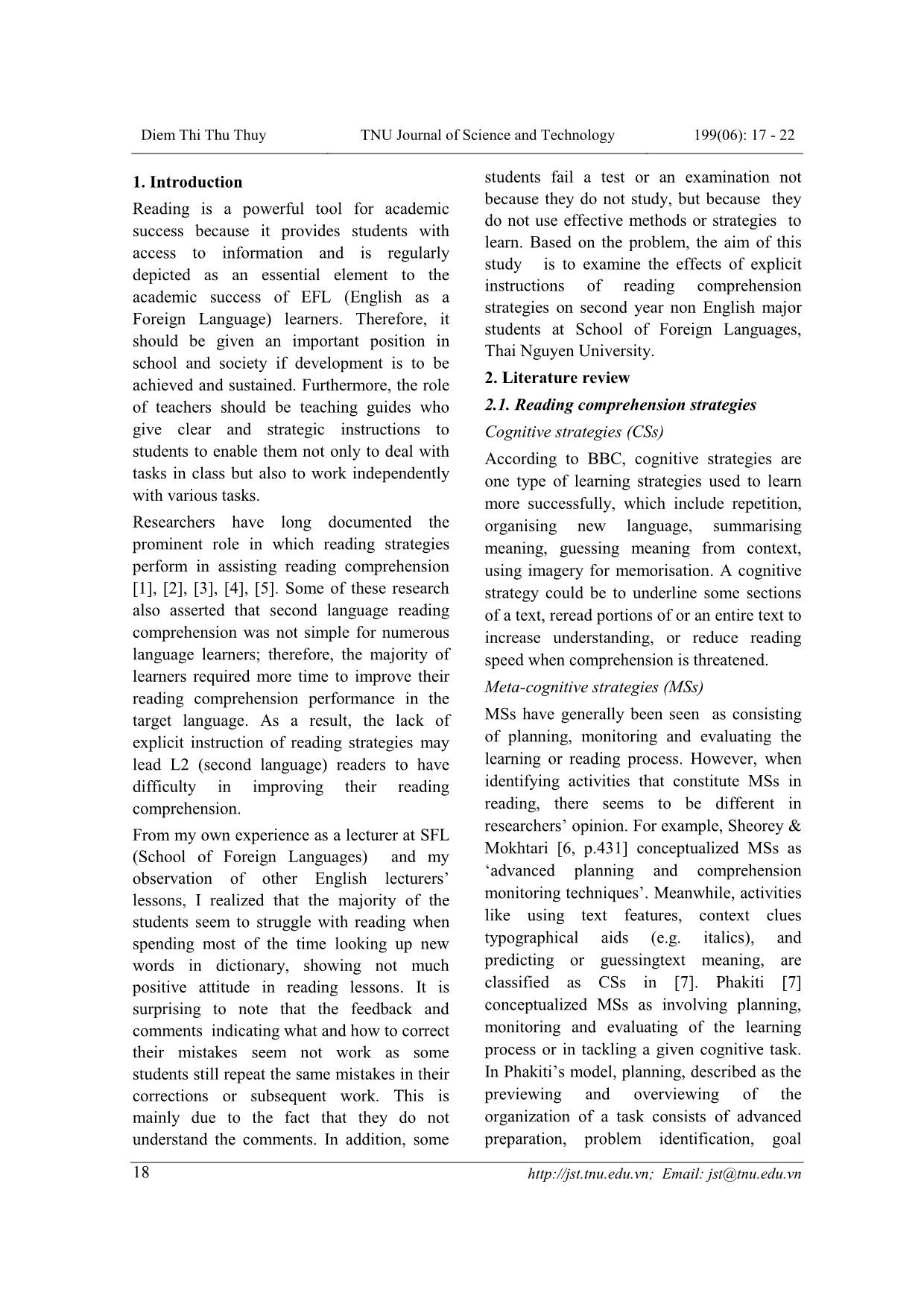
Trang 2
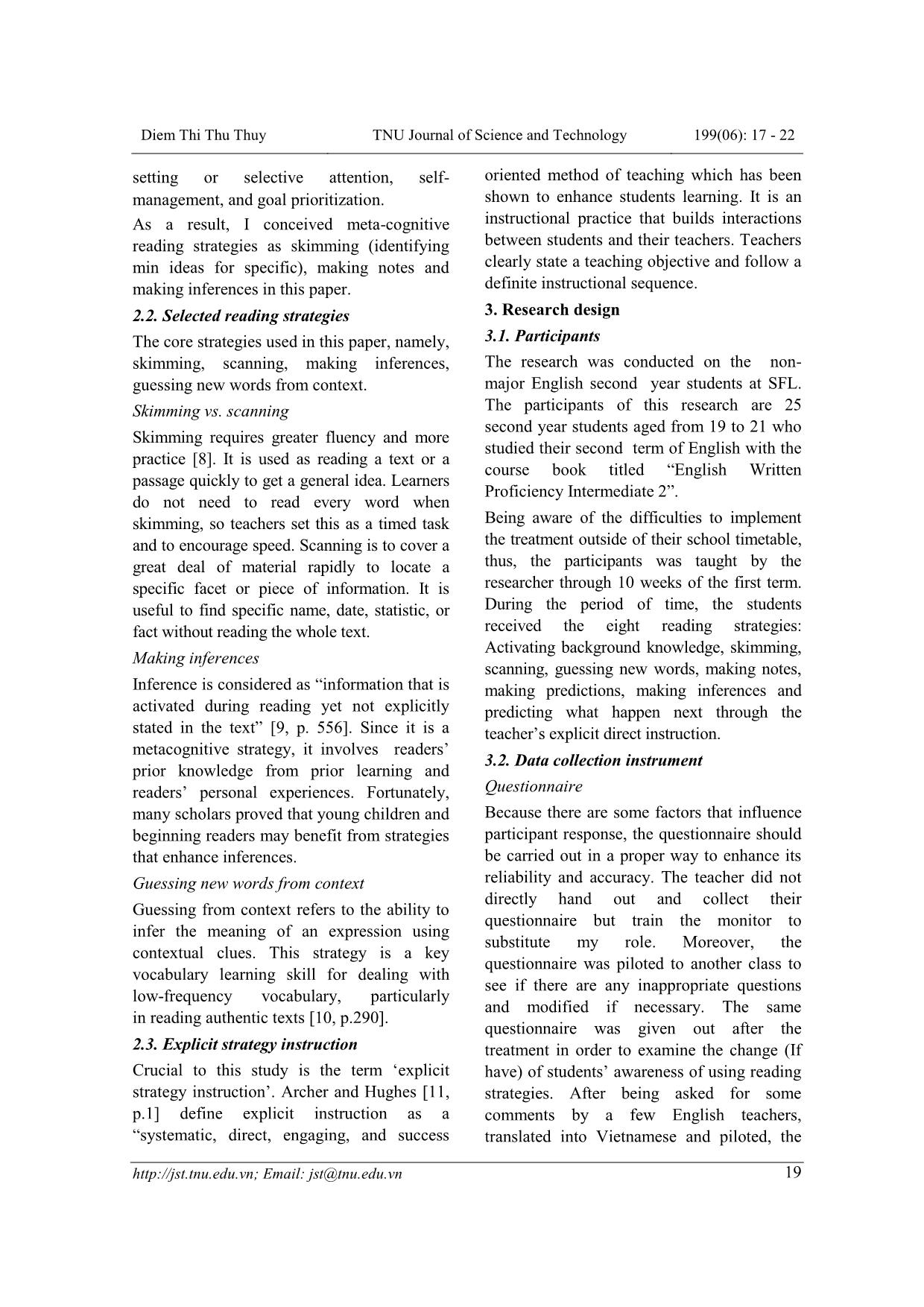
Trang 3
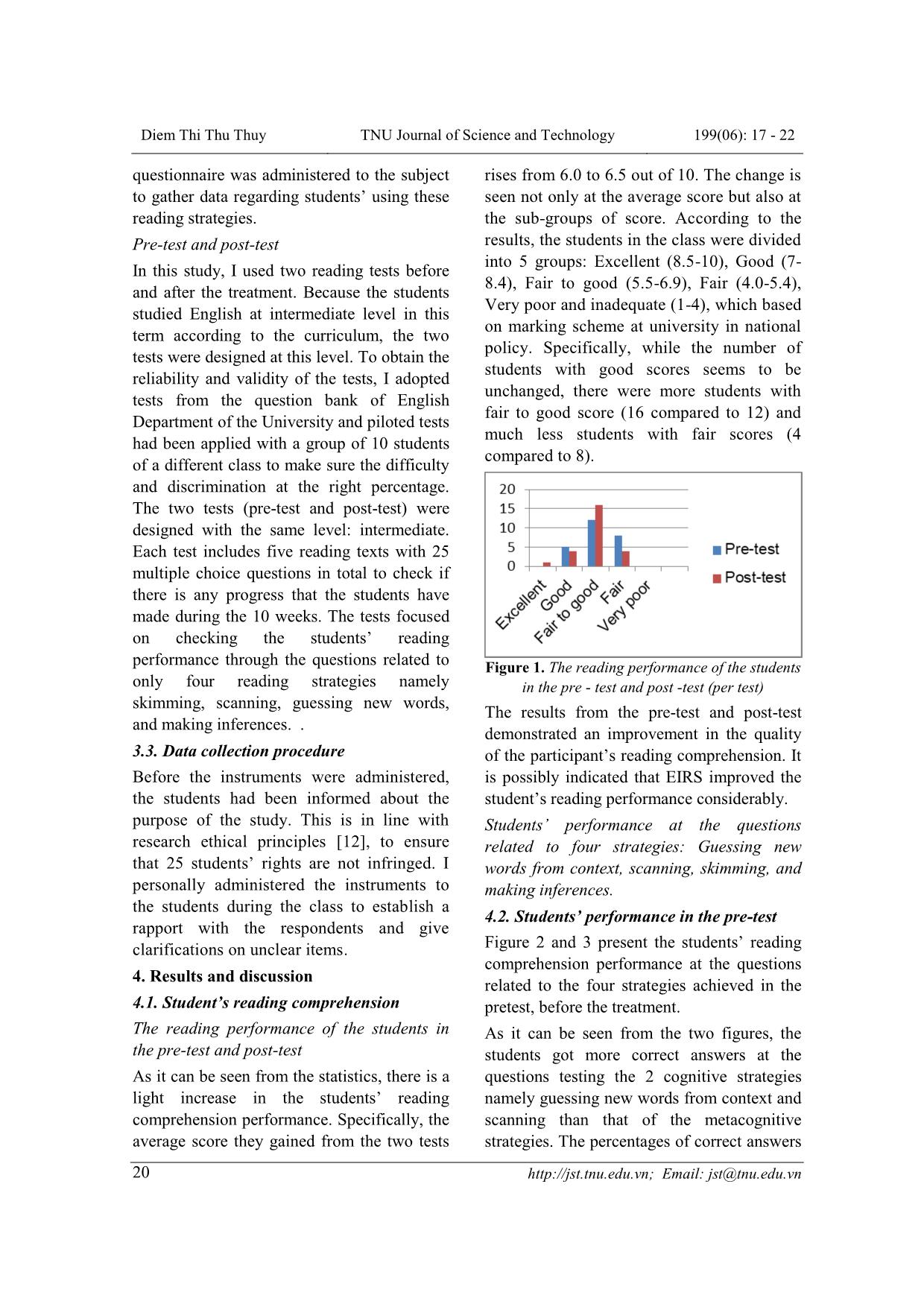
Trang 4
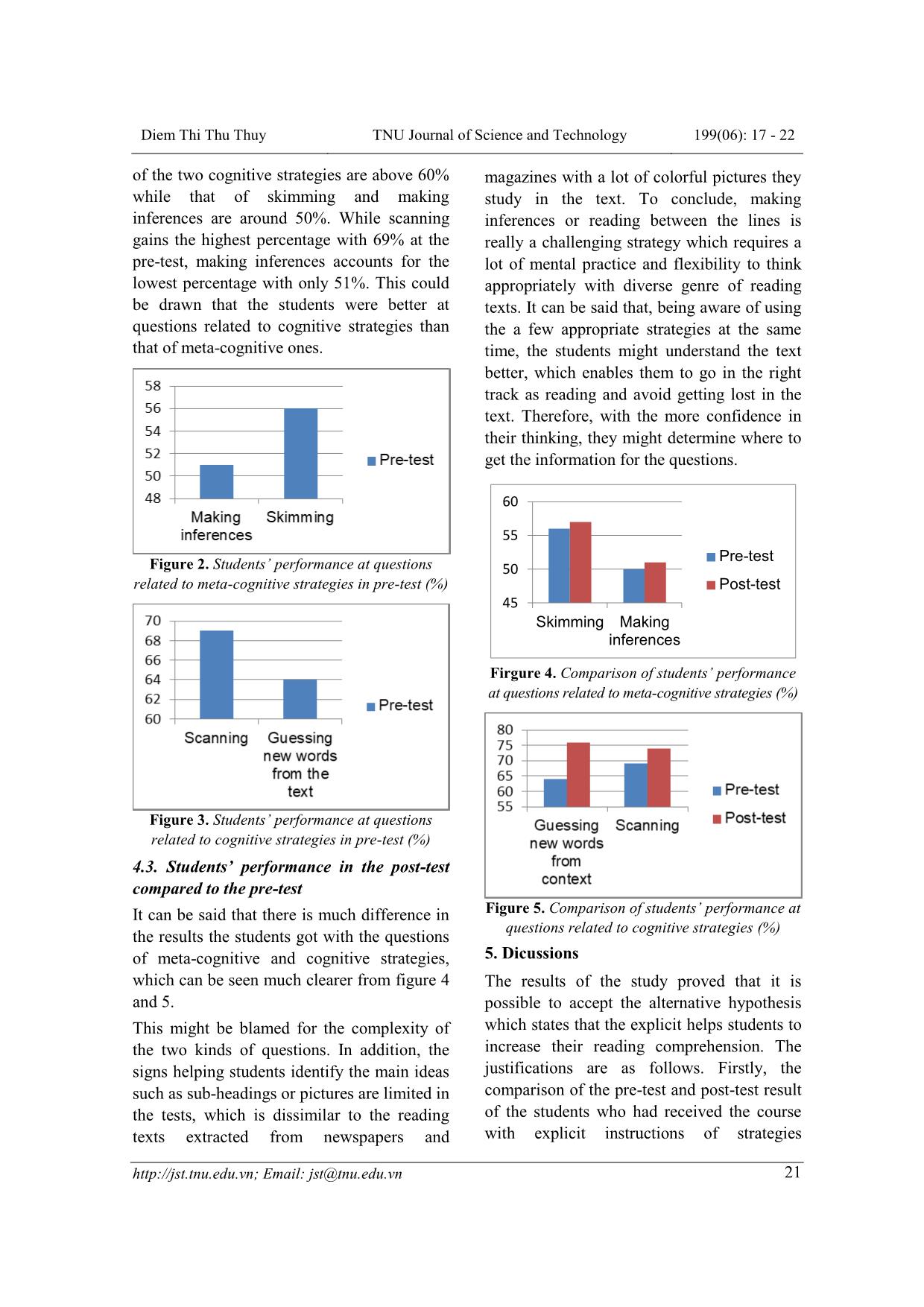
Trang 5
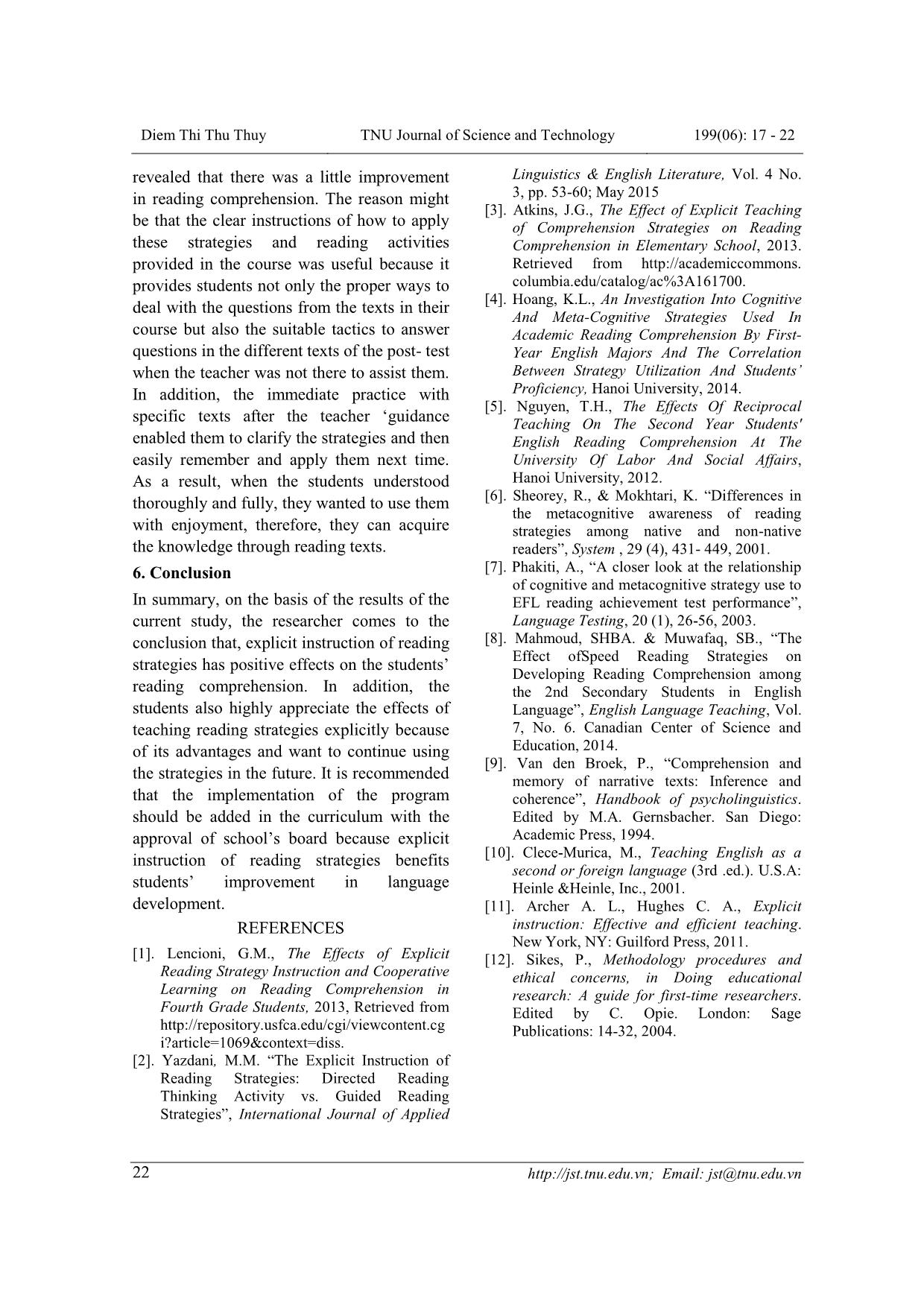
Trang 6
Bạn đang xem tài liệu "Ảnh hưởng của lời dẫn tường minh cho các chiến lược đọc đến kỹ năng đọc hiểu tại khoa Ngoại ngữ, Đại học Thái Nguyên", để tải tài liệu gốc về máy hãy click vào nút Download ở trên
Tóm tắt nội dung tài liệu: Ảnh hưởng của lời dẫn tường minh cho các chiến lược đọc đến kỹ năng đọc hiểu tại khoa Ngoại ngữ, Đại học Thái Nguyên
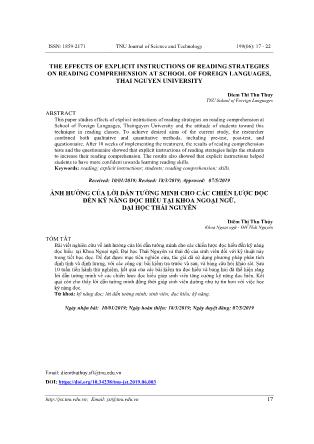
xt, reread portions of or an entire text to increase understanding, or reduce reading speed when comprehension is threatened. Meta-cognitive strategies (MSs) MSs have generally been seen as consisting of planning, monitoring and evaluating the learning or reading process. However, when identifying activities that constitute MSs in reading, there seems to be different in researchers‟ opinion. For example, Sheorey & Mokhtari [6, p.431] conceptualized MSs as „advanced planning and comprehension monitoring techniques‟. Meanwhile, activities like using text features, context clues typographical aids (e.g. italics), and predicting or guessingtext meaning, are classified as CSs in [7]. Phakiti [7] conceptualized MSs as involving planning, monitoring and evaluating of the learning process or in tackling a given cognitive task. In Phakiti‟s model, planning, described as the previewing and overviewing of the organization of a task consists of advanced preparation, problem identification, goal Diem Thi Thu Thuy TNU Journal of Science and Technology 199(06): 17 - 22 Email: jst@tnu.edu.vn 19 setting or selective attention, self- management, and goal prioritization. As a result, I conceived meta-cognitive reading strategies as skimming (identifying min ideas for specific), making notes and making inferences in this paper. 2.2. Selected reading strategies The core strategies used in this paper, namely, skimming, scanning, making inferences, guessing new words from context. Skimming vs. scanning Skimming requires greater fluency and more practice [8]. It is used as reading a text or a passage quickly to get a general idea. Learners do not need to read every word when skimming, so teachers set this as a timed task and to encourage speed. Scanning is to cover a great deal of material rapidly to locate a specific facet or piece of information. It is useful to find specific name, date, statistic, or fact without reading the whole text. Making inferences Inference is considered as “information that is activated during reading yet not explicitly stated in the text” [9, p. 556]. Since it is a metacognitive strategy, it involves readers‟ prior knowledge from prior learning and readers‟ personal experiences. Fortunately, many scholars proved that young children and beginning readers may benefit from strategies that enhance inferences. Guessing new words from context Guessing from context refers to the ability to infer the meaning of an expression using contextual clues. This strategy is a key vocabulary learning skill for dealing with low-frequency vocabulary, particularly in reading authentic texts [10, p.290]. 2.3. Explicit strategy instruction Crucial to this study is the term „explicit strategy instruction‟. Archer and Hughes [11, p.1] define explicit instruction as a “systematic, direct, engaging, and success oriented method of teaching which has been shown to enhance students learning. It is an instructional practice that builds interactions between students and their teachers. Teachers clearly state a teaching objective and follow a definite instructional sequence. 3. Research design 3.1. Participants The research was conducted on the non- major English second year students at SFL. The participants of this research are 25 second year students aged from 19 to 21 who studied their second term of English with the course book titled “English Written Proficiency Intermediate 2”. Being aware of the difficulties to implement the treatment outside of their school timetable, thus, the participants was taught by the researcher through 10 weeks of the first term. During the period of time, the students received the eight reading strategies: Activating background knowledge, skimming, scanning, guessing new words, making notes, making predictions, making inferences and predicting what happen next through the teacher‟s explicit direct instruction. 3.2. Data collection instrument Questionnaire Because there are some factors that influence participant response, the questionnaire should be carried out in a proper way to enhance its reliability and accuracy. The teacher did not directly hand out and collect their questionnaire but train the monitor to substitute my role. Moreover, the questionnaire was piloted to another class to see if there are any inappropriate questions and modified if necessary. The same questionnaire was given out after the treatment in order to examine the change (If have) of students‟ awareness of using reading strategies. After being asked for some comments by a few English teachers, translated into Vietnamese and piloted, the Diem Thi Thu Thuy TNU Journal of Science and Technology 199(06): 17 - 22 Email: jst@tnu.edu.vn 20 questionnaire was administered to the subject to gather data regarding students‟ using these reading strategies. Pre-test and post-test In this study, I used two reading tests before and after the treatment. Because the students studied English at intermediate level in this term according to the curriculum, the two tests were designed at this level. To obtain the reliability and validity of the tests, I adopted tests from the question bank of English Department of the University and piloted tests had been applied with a group of 10 students of a different class to make sure the difficulty and discrimination at the right percentage. The two tests (pre-test and post-test) were designed with the same level: intermediate. Each test includes five reading texts with 25 multiple choice questions in total to check if there is any progress that the students have made during the 10 weeks. The tests focused on checking the students‟ reading performance through the questions related to only four reading strategies namely skimming, scanning, guessing new words, and making inferences. . 3.3. Data collection procedure Before the instruments were administered, the students had been informed about the purpose of the study. This is in line with research ethical principles [12], to ensure that 25 students‟ rights are not infringed. I personally administered the instruments to the students during the class to establish a rapport with the respondents and give clarifications on unclear items. 4. Results and discussion 4.1. Student’s reading comprehension The reading performance of the students in the pre-test and post-test As it can be seen from the statistics, there is a light increase in the students‟ reading comprehension performance. Specifically, the average score they gained from the two tests rises from 6.0 to 6.5 out of 10. The change is seen not only at the average score but also at the sub-groups of score. According to the results, the students in the class were divided into 5 groups: Excellent (8.5-10), Good (7- 8.4), Fair to good (5.5-6.9), Fair (4.0-5.4), Very poor and inadequate (1-4), which based on marking scheme at university in national policy. Specifically, while the number of students with good scores seems to be unchanged, there were more students with fair to good score (16 compared to 12) and much less students with fair scores (4 compared to 8). Figure 1. The reading performance of the students in the pre - test and post -test (per test) The results from the pre-test and post-test demonstrated an improvement in the quality of the participant‟s reading comprehension. It is possibly indicated that EIRS improved the student‟s reading performance considerably. Students’ performance at the questions related to four strategies: Guessing new words from context, scanning, skimming, and making inferences. 4.2. Students’ performance in the pre-test Figure 2 and 3 present the students‟ reading comprehension performance at the questions related to the four strategies achieved in the pretest, before the treatment. As it can be seen from the two figures, the students got more correct answers at the questions testing the 2 cognitive strategies namely guessing new words from context and scanning than that of the metacognitive strategies. The percentages of correct answers Diem Thi Thu Thuy TNU Journal of Science and Technology 199(06): 17 - 22 Email: jst@tnu.edu.vn 21 of the two cognitive strategies are above 60% while that of skimming and making inferences are around 50%. While scanning gains the highest percentage with 69% at the pre-test, making inferences accounts for the lowest percentage with only 51%. This could be drawn that the students were better at questions related to cognitive strategies than that of meta-cognitive ones. Figure 2. Students’ performance at questions related to meta-cognitive strategies in pre-test (%) Figure 3. Students’ performance at questions related to cognitive strategies in pre-test (%) 4.3. Students’ performance in the post-test compared to the pre-test It can be said that there is much difference in the results the students got with the questions of meta-cognitive and cognitive strategies, which can be seen much clearer from figure 4 and 5. This might be blamed for the complexity of the two kinds of questions. In addition, the signs helping students identify the main ideas such as sub-headings or pictures are limited in the tests, which is dissimilar to the reading texts extracted from newspapers and magazines with a lot of colorful pictures they study in the text. To conclude, making inferences or reading between the lines is really a challenging strategy which requires a lot of mental practice and flexibility to think appropriately with diverse genre of reading texts. It can be said that, being aware of using the a few appropriate strategies at the same time, the students might understand the text better, which enables them to go in the right track as reading and avoid getting lost in the text. Therefore, with the more confidence in their thinking, they might determine where to get the information for the questions. 45 50 55 60 Skimming Making inferences Pre-test Post-test Firgure 4. Comparison of students’ performance at questions related to meta-cognitive strategies (%) Figure 5. Comparison of students’ performance at questions related to cognitive strategies (%) 5. Dicussions The results of the study proved that it is possible to accept the alternative hypothesis which states that the explicit helps students to increase their reading comprehension. The justifications are as follows. Firstly, the comparison of the pre-test and post-test result of the students who had received the course with explicit instructions of strategies Diem Thi Thu Thuy TNU Journal of Science and Technology 199(06): 17 - 22 Email: jst@tnu.edu.vn 22 revealed that there was a little improvement in reading comprehension. The reason might be that the clear instructions of how to apply these strategies and reading activities provided in the course was useful because it provides students not only the proper ways to deal with the questions from the texts in their course but also the suitable tactics to answer questions in the different texts of the post- test when the teacher was not there to assist them. In addition, the immediate practice with specific texts after the teacher „guidance enabled them to clarify the strategies and then easily remember and apply them next time. As a result, when the students understood thoroughly and fully, they wanted to use them with enjoyment, therefore, they can acquire the knowledge through reading texts. 6. Conclusion In summary, on the basis of the results of the current study, the researcher comes to the conclusion that, explicit instruction of reading strategies has positive effects on the students‟ reading comprehension. In addition, the students also highly appreciate the effects of teaching reading strategies explicitly because of its advantages and want to continue using the strategies in the future. It is recommended that the implementation of the program should be added in the curriculum with the approval of school‟s board because explicit instruction of reading strategies benefits students‟ improvement in language development. REFERENCES [1]. Lencioni, G.M., The Effects of Explicit Reading Strategy Instruction and Cooperative Learning on Reading Comprehension in Fourth Grade Students, 2013, Retrieved from i?article=1069&context=diss. [2]. Yazdani, M.M. “The Explicit Instruction of Reading Strategies: Directed Reading Thinking Activity vs. Guided Reading Strategies”, International Journal of Applied Linguistics & English Literature, Vol. 4 No. 3, pp. 53-60; May 2015 [3]. Atkins, J.G., The Effect of Explicit Teaching of Comprehension Strategies on Reading Comprehension in Elementary School, 2013. Retrieved from columbia.edu/catalog/ac%3A161700. [4]. Hoang, K.L., An Investigation Into Cognitive And Meta-Cognitive Strategies Used In Academic Reading Comprehension By First- Year English Majors And The Correlation Between Strategy Utilization And Students’ Proficiency, Hanoi University, 2014. [5]. Nguyen, T.H., The Effects Of Reciprocal Teaching On The Second Year Students' English Reading Comprehension At The University Of Labor And Social Affairs, Hanoi University, 2012. [6]. Sheorey, R., & Mokhtari, K. “Differences in the metacognitive awareness of reading strategies among native and non-native readers”, System , 29 (4), 431- 449, 2001. [7]. Phakiti, A., “A closer look at the relationship of cognitive and metacognitive strategy use to EFL reading achievement test performance”, Language Testing, 20 (1), 26-56, 2003. [8]. Mahmoud, SHBA. & Muwafaq, SB., “The Effect ofSpeed Reading Strategies on Developing Reading Comprehension among the 2nd Secondary Students in English Language”, English Language Teaching, Vol. 7, No. 6. Canadian Center of Science and Education, 2014. [9]. Van den Broek, P., “Comprehension and memory of narrative texts: Inference and coherence”, Handbook of psycholinguistics. Edited by M.A. Gernsbacher. San Diego: Academic Press, 1994. [10]. Clece-Murica, M., Teaching English as a second or foreign language (3rd .ed.). U.S.A: Heinle &Heinle, Inc., 2001. [11]. Archer A. L., Hughes C. A., Explicit instruction: Effective and efficient teaching. New York, NY: Guilford Press, 2011. [12]. Sikes, P., Methodology procedures and ethical concerns, in Doing educational research: A guide for first-time researchers. Edited by C. Opie. London: Sage Publications: 14-32, 2004.
File đính kèm:
 anh_huong_cua_loi_dan_tuong_minh_cho_cac_chien_luoc_doc_den.pdf
anh_huong_cua_loi_dan_tuong_minh_cho_cac_chien_luoc_doc_den.pdf

